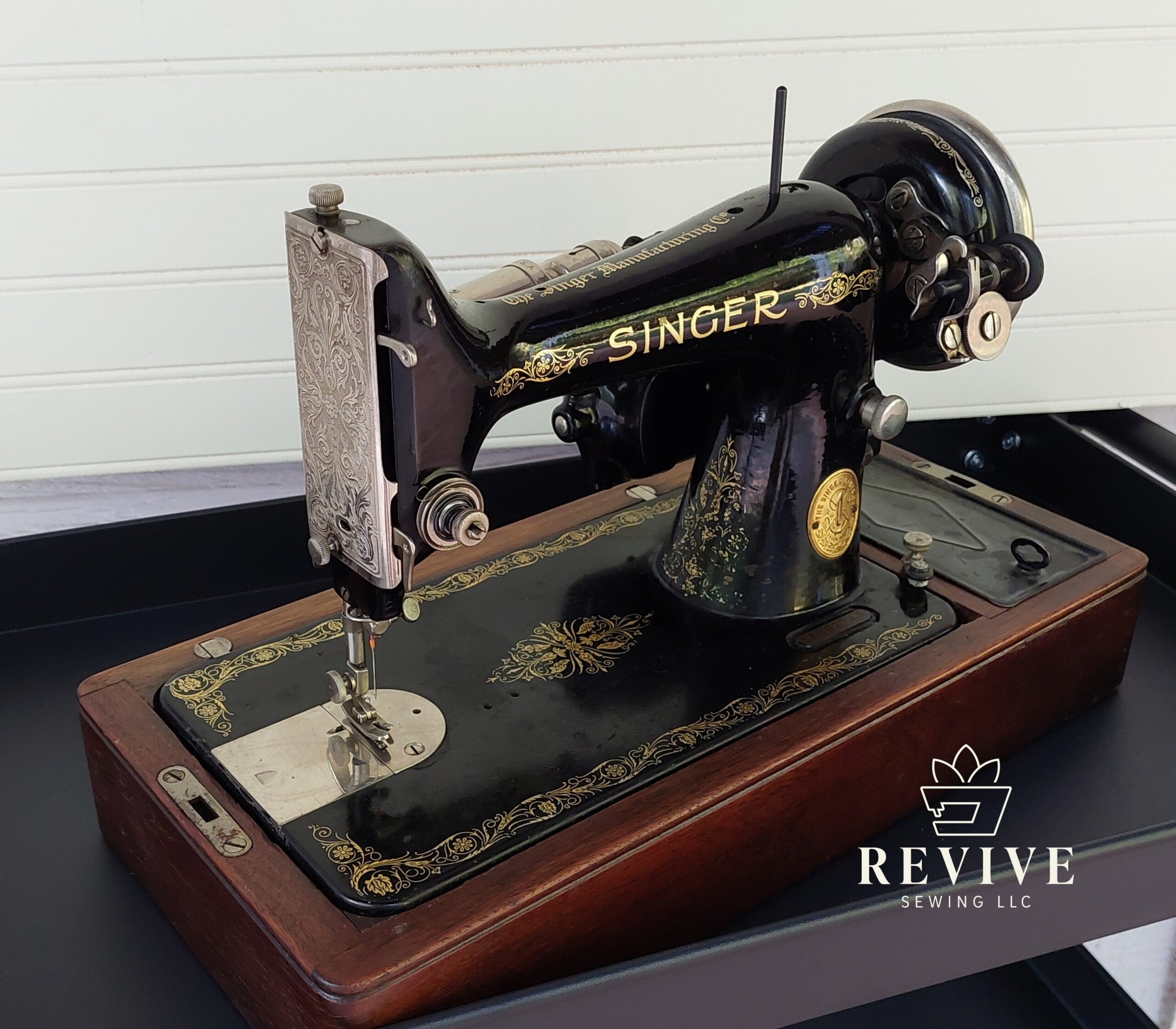Your cart is currently empty!

Sewing Machine Conservation or Restoration: What’s Right for You?
When it comes to vintage and antique sewing machines, beauty and function often go hand-in-hand. These machines were built to last—and look good doing it. Whether they’re gleaming black Singers with gold decals or pastel-colored mid-century marvels, their appeal lies not only in how well they stitch but in how they carry the stories of past generations and the potential for future ones.
But what happens when that finish is scratched, the decals are fading, or the cabinet is showing its age? That’s when two different cosmetic approaches can be chosen for your sewing machine: conservation or restoration.
Both approaches aim to get your machine sewing again, but they take very different paths when it comes to aesthetics and historical integrity. Let’s explore the difference and how to decide which is right for you.
Cosmetic Conservation: Preserve the Past
Cosmetic conservation focuses on stabilizing and preserving the original finish of both the sewing machine and its cabinet or wood case, if it has one. Rather than making something look new, conservation aims to protect what’s already there and prevent further damage.
What It Includes:
- Gentle cleaning to remove dust, grime, and oxidation on any metal parts, including bare metal on the machine or hardware on the cabinet
- Careful polishing of metal without removing patina
- Depending on the machine finish, a new coat of wax or oil is applied to stabilize and protect the decals to prevent further flaking
- Depending on the finish of the cabinet, waxing or conditioning of wood finishes without stripping
- Light cabinet or case repair only if necessary for stability and approved by the customer
In short, conservation is a museum-minded approach. It honors every scuff, every worn edge of the decals, every fingerprint in the shellac. The goal is to slow deterioration, not erase time.
This method is ideal for machines with original finishes that still hold their charm, or for collectors who value authenticity over a showroom shine.

The Singer 99 model shown here is an excellent candidate for cosmetic conservation. The decals are in good condition with minimal flaking. The paint finish still has shine to it, and the metal plates do not show signs of rust. The bentwood case base is also in excellent condition.
Full Restoration: Back to Beauty
Full restoration is a more intensive process that brings a machine and its cabinet or case back to near-original—or even custom—condition. It often involves cosmetic transformation as well as mechanical repair.
What It Includes:
- Complete disassembly, cleaning, and polishing
- Paint stripping and full repainting of the sewing machine
- Custom or replica decal application
- Polishing of metal parts, or sometimes refinishing, depending on the condition
- Repairing or replacing broken wood components and gluing loose veneer
- Stripping and refinishing the cabinet
Restoration allows for creativity and personalization. You might choose a historically accurate color and decal set, or go bold with a custom color and high-gloss clear coat. Cabinets can be revived with rich stains or painted finishes to match your space.
Restoration is perfect for machines that are too far gone for gentle cleaning to make a difference, or for those who want a true statement piece that sews like new.

This Singer 128 would be a good candidate for restoration. The decals on the machine bed are completely worn away on the front, and damage to the paint bed is showing bare metal on the front edge with some signs of oxidation starting. The owner of this machine can choose to restore it to the original glossy black paint and decals, or choose a new and exciting color and decals to customize it.
Choosing Between Sewing Machine Conservation or Restoration
Not sure which path is right for your machine? Here are a few things to consider:
- Historical or Sentimental Value: If your machine is a family heirloom, preserving its original finish might be more meaningful than a full cosmetic overhaul. Conservation keeps the character and stories intact.
- Condition: Machines with flaking paint, missing decals, or badly damaged cabinets may benefit more from restoration. If the finish is already compromised, restoring it can bring new life without much loss of originality.
- Intended Use: Are you going to use this machine every day? Display it in a shop or studio? Daily-use machines often benefit from restoration—they’re easier to clean, more durable, and can run better with full mechanical tuning.
- Budget: Conservation is typically less expensive than a full restoration, since it involves fewer materials and less labor. Restoration, especially the high-quality automotive paint, catalyst-hardened clear coat, and wood finishes we use, is an investment.
- Resale or Collectability: Some collectors place a premium on originality, while others value pristine looks. If you’re thinking about resale, know your market: purists may prefer conservation, while hobby sewists might gravitate toward restored pieces.
- Individuality: Many people choose the Restoration route as a way to get a unique sewing machine tailored to their exact tastes. Bright, vibrant colors, custom artwork on the decals, and even custom-fabricated cover plates can all turn your sewing machine into your creative calling card.
Final Thoughts on Sewing Machine Conservation or Restoration
Whether you’re restoring a treasure to its former glory or preserving its well-earned patina, the most important thing is that your machine lives on and stitches again. Both conservation and restoration celebrate the craftsmanship of vintage sewing machines, just in different ways.
If you’re unsure where to begin, reach out for help to assess your machine and decide what’s possible and appropriate for its condition and your goals. If you already know what you want, join our waitlist to bring your vision to life.
After all, every machine has a story. It’s up to you how you want to tell it.
